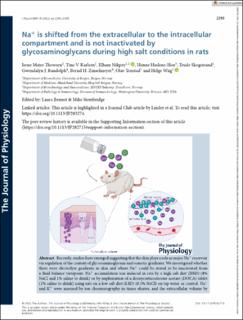| dc.contributor.author | Thowsen, Irene Matre | |
| dc.contributor.author | Karlsen, Tine Veronica | |
| dc.contributor.author | Nikpey, Elham | |
| dc.contributor.author | Haslene-Hox, Hanne | |
| dc.contributor.author | Skogstrand, Trude | |
| dc.contributor.author | Randolph, Gwendalyn J. | |
| dc.contributor.author | Zinselmeyer, Bernd H. | |
| dc.contributor.author | Tenstad, Olav | |
| dc.contributor.author | Wiig, Helge | |
| dc.date.accessioned | 2023-01-24T11:11:27Z | |
| dc.date.available | 2023-01-24T11:11:27Z | |
| dc.date.created | 2022-05-15T14:30:56Z | |
| dc.date.issued | 2022 | |
| dc.identifier.citation | Journal of Physiology. 2022, 600 (10), 2293-2309. | en_US |
| dc.identifier.issn | 0022-3751 | |
| dc.identifier.uri | https://hdl.handle.net/11250/3045792 | |
| dc.description.abstract | Recently, studies have emerged suggesting that the skin plays a role as major Na+ reservoir via regulation of the content of glycosaminoglycans and osmotic gradients. We investigated whether there were electrolyte gradients in skin and where Na+ could be stored to be inactivated from a fluid balance viewpoint. Na+ accumulation was induced in rats by a high salt diet (HSD) (8% NaCl and 1% saline to drink) or by implantation of a deoxycorticosterone acetate (DOCA) tablet (1% saline to drink) using rats on a low salt diet (LSD) (0.1% NaCl) on tap water as control. Na+ and K+ were assessed by ion chromatography in tissue eluates, and the extracellular volume by equilibration of 51Cr-EDTA. By tangential sectioning of the skin, we found a low Na+ content and extracellular volume in epidermis, both parameters rising by ∼30% and 100%, respectively, in LSD and even more in HSD and DOCA when entering dermis. We found evidence for an extracellular Na+ gradient from epidermis to dermis shown by an estimated concentration in epidermis ∼2 and 4–5 times that of dermis in HSD and DOCA-salt. There was intracellular storage of Na+ in skin, muscle, and myocardium without a concomitant increase in hydration. Our data suggest that there is a hydration-dependent high interstitial fluid Na+ concentration that will contribute to the skin barrier and thus be a mechanism for limiting water loss. Salt stress results in intracellular storage of Na+ in exchange with K+ in skeletal muscle and myocardium that may have electromechanical consequences. | en_US |
| dc.language.iso | eng | en_US |
| dc.publisher | Wiley | en_US |
| dc.rights | Navngivelse-Ikkekommersiell 4.0 Internasjonal | * |
| dc.rights.uri | http://creativecommons.org/licenses/by-nc/4.0/deed.no | * |
| dc.title | Na+ is shifted from the extracellular to the intracellular compartment and is not inactivated by glycosaminoglycans during high salt conditions in rats | en_US |
| dc.title.alternative | Na+ is shifted from the extracellular to the intracellular compartment and is not inactivated by glycosaminoglycans during high salt conditions in rats | en_US |
| dc.type | Peer reviewed | en_US |
| dc.type | Journal article | en_US |
| dc.description.version | publishedVersion | en_US |
| dc.rights.holder | © 2022 The Authors.The Journal of Physiologypublished by John Wiley & Sons Ltd on behalf of The Physiological Society | en_US |
| dc.source.pagenumber | 2293-2309 | en_US |
| dc.source.volume | 600 | en_US |
| dc.source.journal | Journal of Physiology | en_US |
| dc.source.issue | 10 | en_US |
| dc.identifier.doi | 10.1113/JP282715 | |
| dc.identifier.cristin | 2024690 | |
| cristin.ispublished | true | |
| cristin.fulltext | original | |
| cristin.qualitycode | 2 | |

